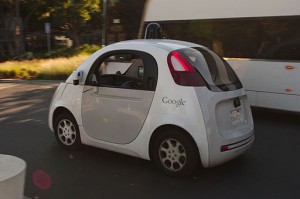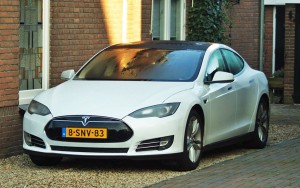Vehicles, trains, ferries, planes – just examples of the wide range of transportation methods available in the modern day. All of these methods require a human operator, however, we are soon to be introduced to a method seldom heard of: self-driving cars. In 2009, Google launched the Self-Driving Car Project and began development of a vehicle that drives itself from point A to point B without the need of a driver.

Image: Wikimedia (by Michael Shick); Google Self-Driving Car in Mountain View, CA, USA.
An operating software works alongside the sensor seen visibly on top of the vehicle. The sensor consists of lasers and cameras, and it is able to differentiate surrounding objects by a combination of size, speed and shape. With this information, the software is able to anticipate what happens next (for example, if a cyclist passes by). In the current prototype, the car has no pedals nor steering wheel – the only way humans can control the driving is a red button for emergencies. Google’s prototypes have been released in California and are expected to be released to the public by 2020.

Other examples of self-driving vehicles include Tesla models, which have been on the roads of Canada. Compared to Google’s project, Tesla’s models are not entirely automatic, as they still require a driver to command lane changes and they require a driver to be present and touching the steering wheel periodically. Nonetheless, it still contains functions such as cruise control, automatic parking,

Image: Wikimedia (by Niels de Wit); Tesla Model S, first Tesla to have autopilot software.
hand-free lane changes, and top speed limit.
Apart from not needing a driver, what else does a self-driving car offer? Google’s prototype is environmentally friendly because it is completely battery powered. The computer of the vehicle is also programmed to drive safely, although Google has the ability to set the aggressiveness of the drive. Consultancy firm KPMC predicts self-driving cars can reduce accidents by 80% and an estimated 2500 fewer deaths due to car accidents between 2014 to 2040.
The self-driving car still has it’s limitations though. The software in all models are still to be perfected and we are still seeing accidents in prototypes. Questions have also been raised about common driving circumstances, such us backing up a few feet for convenience, or deciding if someone should be let into your lane. If every car on the road was programmed, perhaps we could little to no car accidents. However both the hardware and software is fairly expensive, such as Tesla’s software requiring a $3000 add on. In addition there are various legal issues. Ontario still requires a driver to be in the driver’s seat at all times. Responsibility of accidents are still to be decided between the user and manufacture.
With many factors still unknown, the popularity of the self-driving car in the future is still debatable. However, we can continue to expect steps in development and new self-driving models to appear.
Daryl
